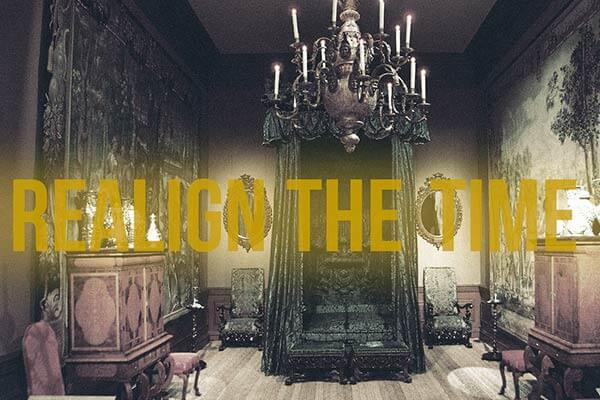
Since their formation in 2010, Quince Contemporary Vocal Ensemble has dedicated itself to commissioning and premiering new works for female, a cappella vocal quartet. They have performed around the country and collaborated with many composers and other new music ensembles with unique aplomb and versatility. This passion shows through their recently released debut album “Realign the Time,” an introspective but vibrant collection of works written especially for them.
“Realign the Time” opens with Max Grafe’s Three Madrigals, an energetic Wallace Stevens setting. Full of evocative onomatopoeia and rhythmic ostinatos, Quince’s crisp diction provides an unexpected but satisfying balance to Stevens’ surreal poetry. The setting is particularly effective in the last movement, “Fabliau of Florida.” The repeated final word – “surf” – slowly dissolves its single vowel into undulating imitation of the tide.
Amanda Feery composed her haunting Squarepushers by rearranging small scraps of paper containing short musical ideas. It’s easy to visualize this bricolage of a process as the quartet navigates the quasi-improvisatory piece with closed-mouth hums that open to wider vowels, the simple melodic motives overlapping in a thick texture. A modal chant – “realign the time” – emerges from the restless vocalise. Quince’s nuanced interpretation of Squarepushers’ captivating simplicity makes this piece a standout on the album.
Jonathan Sokol’s Le Salève sets a poem by Jessica Rooney, a dreamy and meandering text about the halcyon days of summer. Recitative-like, the quartet whispers evocative alliterations (“Silence strong, sirensong, swaying shaped, sure…”), which transform into direct, almost barbershop quartet-like chords that slide fluidly from one to another. The effect is endearing, a simple nostalgic scene rendered in an obscuring fog of sibilance and memory. No other piece on the album better highlights Quince’s versatility, seamlessly alternating between special effects and more straightforward singing.
Quince Contemporary Vocal Ensemble
Decantations by Ravi Kittappa features an incessant drone provided by sruti boxes, among which the ensemble utters fragmentary text from the 10th century Siddhar poet Sivavakkiyar. The Tamil words are sometimes spoken, sometimes sung in plaintive monotone against the buzzing sruti boxes, which pile in increasingly dissonant clusters. In the final section, each singer adds her voice to a rising vertical figure, finally opening into expressive, full-voiced chords. The surprise of the sruti boxes and a rainstick add nice timbral variety to the middle of the album.
David Grant’s Hommage is an entirely wordless chorale in which all four singers often pass through each other’s ranges as they navigate a slowly oscillating, sinuous chord progression. Though relatively unmemorable in comparison to the other works on the album, it does highlight Quince’s unified sound, especially in a very exposed, austere texture.
The three movements of Morgan Krauss’ uncanny and intimate so evenings die lets the ensemble explore the thin line between utterance and song. Opening with a single soprano voice on a brittle, unadorned note, the rest of the ensemble enters with crackling but sustained pitches, punctuated by dramatic gasps. Similarly mysterious and visceral music follows, the quartet rasping fascinating, primal lullabies. The third movement closes with another Wallace Stevens setting (from the appropriately titled “Peter Quince at the Clavier”), an insistent whisper that eventually subsumes the ensemble: “the body dies; the body’s beauty lives.”
Finally, Anthony T. Marasco’s Communiqué tells a story of unrequited love, recalling a changing relationship with a narrator’s close friend, Karen, who moves from the United States to Glasgow. Karen communicates cryptically through “anonymous” postcards sent from all over the European continent, their various languages masking her complicated feelings for the narrator. While Liz Pearse recites the text, the rest of the ensemble sings postcard-length phrases in different languages, impassioned but often unintelligible like so many letters sent across the Atlantic. Occasionally an synthesizer arpeggio reminds the listener that the long-distance longing is a modern lovesickness – as do the references to sending JPEGs over email and catching up on episodes of “Breaking Bad.”
The formidable individual talents of the quartet’s singers belie their strength and blend as a chamber ensemble. Yet each musician retains her unique vocal qualities, making “Realign the Time” a very personable and intimate recording.
